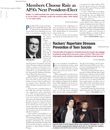With wireless Internet access, you can access your e-mail from your laptop computer or even your personal digital assistant (PDA) with a wireless networking adapter. Nowadays, both of these devices have this adapter built in, but if yours does not, there are numerous companies who make one to fit your laptop computer or PDA.
Most wireless Internet access is available for a charge at different locations such as Starbucks, hotels, airports, and restaurants, but a few locations offer this service for free.
Internet access is also possible through most cellular phone services. You will need a cable to connect your phone to your computer. If your phone and computer have Bluetooth technology, a cable is not necessary. For some of these services, you must have a dial-up account and special software. Be aware that some cellular phone companies charge extra for this data transmission. Check with your cellular phone company for specific requirements and instructions on Internet access.
Many cellular phone companies offer 3G (third-generation networks) for e-mail and Internet access. 3G refers to higher-speed protocols that permit faster data transmission necessary for multimedia. Specific wireless devices such as the Palm Treo, Danger Sidekick, and Research in Motion BlackBerry are designed to be both a mobile phone and e-mail device. A lower-cost alternative to 3G services is to use wireless access protocol (WAP) to get your e-mail on your mobile phone. This service provides the ability to read your mail on the phone, although some people may find the text too small to read. Sending e-mail is rather difficult due to the lack of a keyboard. In addition, many mobile phone carriers can also deliver Yahoo, AOL, or Hotmail to your phone via short message service (SMS) for a small charge per message.
One problem with e-mail accounts is that people change them with their jobs or when they subscribe to a different Internet service provider. Sending a mass e-mail message is one way to communicate a change, but there are a few alternatives. The following provide free services to register your old e-mail and new e-mail addresses.
•.
FreshAddress:<www.freshaddress.com>
•.
Findmemail:<findmemail.com>
•.
EmailChange:<www.emailchange.com>
•.
MailLocate:<www.maillocate.com>
Your colleagues, patients, and friends can search here for an updated address. However, these services are not well known, even though they are free. Most also provide e-mail forwarding for a modest charge.
Return Path, at<www.returnpath.net>, also provides the above service, but with a twist. Once your old and new e-mail addresses are entered into the database, your colleagues and friends can search for the information. However, your new e-mail address will not be released without your permission. In addition, you can notify people about the address change with a message when you upload your address book.
If you use Microsoft Outlook or Outlook Express, you should consider using Plaxo 2.0, an add-in program that can be found at<www.plaxo.com>. This service helps you maintain current contact information in your e-mail client address book. You can send a message to the whole address book or just certain people asking them to update their information while providing your latest contact information. By having this add-in program on a computer at home and work, you can keep your contacts synchronized, in addition to your calendar, notes, and tasks.
Now that you have more advanced knowledge of e-mail, please do not hesitate to send an e-mail from your cellular phone if you have questions or ideas for further topics to me at
[email protected].▪
